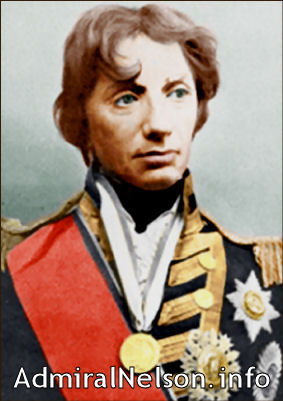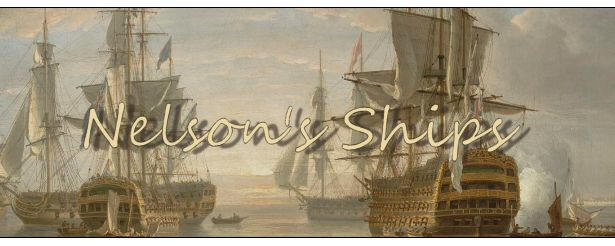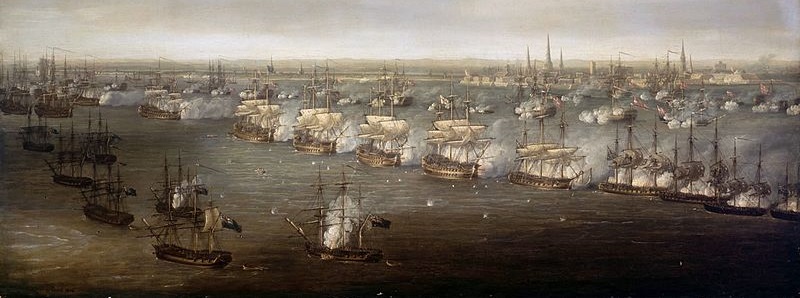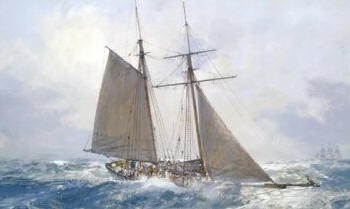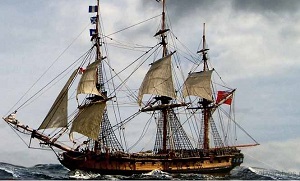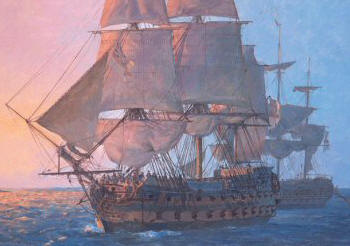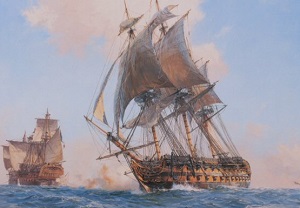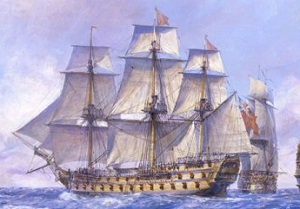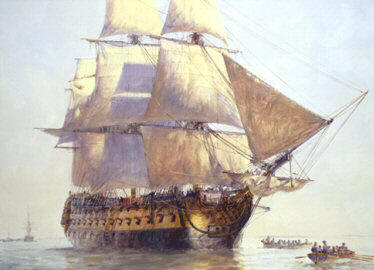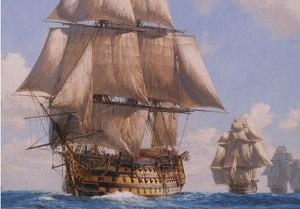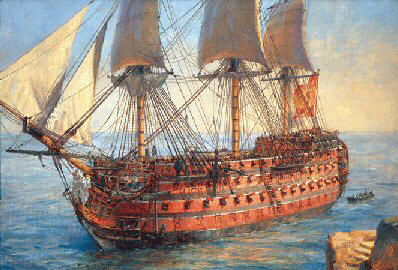|
||
| search engine by freefind |
Copyright Vicki Hassona 2013
Here you will find details of all the ships that Nelson served in,including the dates he served in them, their commanders and key moments in their careers (with and without Nelson). I've also included ships which he didn't serve in, but in which he was a passenger (Alexander, Dolphin, Kite, Lion). I've put the names of their commanders in brackets at the end of each point.
They are laid out below in the order in which Nelson served in them. Click
on the name to be taken to a page with more information.
At the bottom of the page you will find explanations of the ship classifications.
Types and Classes of Ships Bomb Vessel These ships were specifically designed (or converted) to be able to bombard (hence the name) enemy towns and ports, and carried mortars capable of firing explosive shells a long distance. No other type of ship in the navy carried explosive shells. Because of the powerful recoil of the mortars, the hulls of bombs were heavily reinforced, and for that reason they were used for arctic expeditions (as was the Carcass) because they were better able to push through the ice. Bombs were often named after volcanoes or had some other suggestion of fire or explosion, like the Vesuvius and Meteor (but there was also one at the Battle of Copenhagen called the Zebra, which doesn't really fit the pattern!).
The Batttle of Copenhagen by Nicolas Pocock. Bomb vessels can be seen in the bottom left, firing over the lines of British and Danish ships to hit the city in the background.
Unrated Cutters, brigs, and schooners with under 20 guns all fit under the term sloop-of-war. Technically, bombs were also unrated, but their specialist design made them distinct. Cutters were the smallest commissioned vessels of the Royal Navy. They had one mast, and the design of their rigging meant they were extremely quick and manoeuvrable. They usually had around 10 guns and would be commanded by a lieutenant, used for patrols and carrying urgent despatches. Brigs had two square-rigged masts and 10-18 guns. They were fast and easy to manoeuvre, and were often used as cargo or merchant ships. Schooners were a similar size but had fore-and-aft sails, and two or more gaff-rigged masts.
HMS Pickle, a schooner. By Geoff Hunt
Frigates (5th and 6th rate) Frigates were versatile small warships with many important functions. They had 3 square-rigged masts and 20-44 guns on a single gun-deck. They were small enough to be quick and manoeuvrable, but could hold enough stores that they could be at sea for months at a time, and packed enough firepower to intimidate merchant vessels. 6th rates were the smallest rated ships in the Royal Navy, with 20-26 guns, and were often used as convoy escorts or in blockades. They weren't formally recognised by the Admiralty as frigates, but because they were actually rated, they were commanded by post captains, unlike the unrated brigs, cutters and schooners, which had lieutenants or commanders. 5th rates were bigger, with 28-44 guns, and were commanded by captains. They operated alone or in small groups, and because of their combination of speed and firepower would hunt enemy frigates or smaller vessels, often cruising along the coast, and it wasn't at all unheard of for a pair or more frigates to take on a lone ship of the line. There were often frigates present during fleet battles but they wouldn't take part in the fighting and would instead be used to relay signals. Ships of the line wouldn't open fire on a frigate unless provoked. Frigates were also exceptionally useful for reconaissance. Nelson called frigates his 'eyes' and grew frustrated when he felt he didn't have enough. He blamed lack of frigates for not being able to find the French fleet prior to the Battle of the Nile, but he was able to use them to great effect pre-Trafalgar. The position of frigate captain was seen as glamorous, and some, such as Edward Pellew, became famous for their daring, and earned a lot of money from the prizes they captured. Some chose to remain in frigates rather than transfer to a ship of the line, preferring the glory and independence of a frigate command over the prestige of a larger ship.
HMS Seahorse, a 38-gun frigate
Ships of the Line The largest and most heavily-armed ships of
the Age of Sail, of between 64 and 120 guns. The standard naval
tactics of the time for a fleet action were for the fleet to form a 'line of
battle' - hence the name. The lines would form up parallel to each
other, and exchange broadsides (shots from all the guns along the side of
the ship) until one side surrendered. So ships of the line were built
like floating fortresses. The smallest ship
generally considered suitable for a line of battle had 64 guns, though the
Leander,
at the Battle of the Nile, had 50 and did pretty well. But all ships
of the line had to have at least two gundecks. They were ranked as
first, second, third or fourth rates. 4th Rates weren't very common by
Nelson's time. They were two-decked with 50 or 60 guns, and considered
too small to be ships of the line, but too large to be frigates. They
were often used for patrols or in small squadrons.
HMS Leander (by Geoff Hunt), a 50-gun 4th rate that fought at the Battle of the Nile 64-gun 3rd
rates weren't much liked. They were relatively cheap to
produce, but didn't have the firepower or even the sailing qualities of a
74, and no more were built after the American War of Independence.
Nonetheless, Nelson was very fond of his ship
Agamemnon, a
64, and was quite successful with her.
Agamemnon saw a
fair amount of fleet action, and at Trafalgar her small size proved to be an
advantage as the shots of four larger enemy ships which had surrounded her,
mostly passed over her.
74-gun two-decker
3rd rates were
by far the most common and most versatile ships of the line. Their
proportions meant that they sailed quite well, and they had enough guns to
pack a real punch. They were also a compromise on cost, being less
expensive in time and money to produce, compared to the first rates.
They became the standard ship of the line.
2nd rates were an odd and not
popular class. They had three decks and carried between 80 and 98
guns. Their design meant that they didn't sail well and weren't as
useful as a 74 despite having more guns. They were more expensive to
produce than 74s, and they were not enough of an improvement to justify the
extra cost when compared to a first rate.
1st rates
were the largest ships in the Navy, with three decks and 100 to 120 guns.
They were incredibly expensive to produce, maintain, and man. There
weren't very many of them, with perhaps only one or two in a large fleet.
Being so large and heavy, they were difficult to manoeuvre and sailed
slowly, though
Victory
was known to be a better sailer than others of her size. Though they
were immense powerhouses of firepower and able to withstand a lot of damage,
in practice their most significant role was as the Admiral's flagship.
Being the largest ship in the fleet, they were able to provide large
accommodations for an admiral and his staff. Their magnificence and
splendour emphasised the rank of the admiral and were an imposing sight to
the enemy.
The Spanish behemoth Santisima Trinidad was the largest ship of her time, and with an immense four decks and 140 guns, she was a class of her own. But she was exceedingly difficult to handle, and in fact proved to not be very effective in battle. Due to her size, she was a much sought-after prize by British officers.
Santisima Trinidad by Geoff Hunt
|
